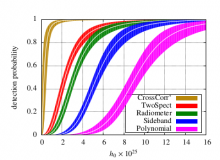
Abstract
The low-mass X-ray binary Scorpius X-1 (Sco X-1) is potentially the most luminous source of continuous gravitational-wave radiation for interferometers such as LIGO and Virgo. For low-mass X-ray binaries this radiation would be sustained by active accretion of matter from its binary companion. With the Advanced Detector Era fast approaching, work is underway to develop an array of robust tools for maximizing the science and detection potential of Sco X-1. We describe the plans and progress of a project designed to compare the numerous independent search algorithms currently available. We employ a mock-data challenge in which the search pipelines are tested for their relative proficiencies in parameter estimation, computational efficiency, robustness, and most importantly, search sensitivity. The mock-data challenge data contains an ensemble of 50 Scorpius X-1 (Sco X-1) type signals, simulated within a frequency band of 50–1500 Hz. Simulated detector noise was generated assuming the expected best strain sensitivity of Advanced LIGO [1] and Advanced VIRGO [2] (4×10−24 Hz−1/2). A distribution of signal amplitudes was then chosen so as to allow a useful comparison of search methodologies. A factor of 2 in strain separates the quietest detected signal, at 6.8×10−26 strain, from the torque-balance limit at a spin frequency of 300 Hz, although this limit could range from 1.2×10−25 (25 Hz) to 2.2×10−26 (750 Hz) depending on the unknown frequency of Sco X-1. With future improvements to the search algorithms and using advanced detector data, our expectations for probing below the theoretical torque-balance strain limit are optimistic.